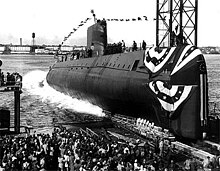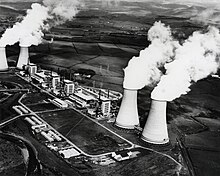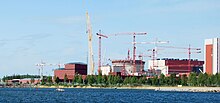NUCLEAR POWER TECHNOLOGY
 |
| The 1200 MWe Leibstadt Nuclear Power Plant in Switzerland. The boiling water reactor (BWR), placed in the dome capped cylindrical structure, is dwarfed in length by way of its cooling tower. The station produces a every year common of 25 million kilowatt-hours per day, sufficient to electricity a city the dimensions of Boston. |
Nuclear power is usings nuclear reactions to produce power. Nuclear energy can be acquired from nuclear fission, nuclear decay and nuclear fusion reactions. Presently, the vast majority of strength from nuclear power is produced through nuclear fission of uranium and plutonium in nuclear power plant life. Nuclear decay processes are used in niche packages such as radioisotope thermoelectric turbines in some space probes which include Voyager 2. Generating strength from fusion strength stays the focal point of worldwide research.
Civilian nuclear electricity furnished 2,586 terawatt hours (TWh) of power in 2019, equal to about 10% of worldwide strength technology, and changed into the second one-largest low-carbon energy supply after hydroelectricity. As of September 2021, there are 444 civilian fission reactors in the world, with a mixed electric capability of 396 gigawatt (GW). There also are 53 nuclear power reactors beneath creation and 98 reactors planned, with a mixed capability of 60 GW and 103 GW, respectively. The United States has the biggest fleet of nuclear reactors, generating over 800 TWh zero-emissions energy according to 12 months with an average capacity factor of 92%. Most reactors under construction are generation III reactors in Asia.
Nuclear strength has one of the lowest degrees of fatalities according to unit of energy generated compared to different power resources. Coal, petroleum, herbal gas and hydroelectricity every have induced more fatalities per unit of energy because of Three Mile Island accident air pollution and accidents. Accidents in nuclear energy flora include the Chernobyl catastrophe within the Soviet Union in 1986, the Fukushima nuclear disaster in Japan in 2011, and the extra contained Three Mile Island accident within the United States in 1979.
There is a debate about nuclear power. Proponents, which include the World Nuclear Association and Environmentalists for Nuclear Energy, contend that nuclear energy is a safe, sustainable strength supply that reduces carbon emissions. Nuclear electricity warring parties, along with Greenpeace, Scientists for Future and NIRS, contend that nuclear power poses many threats to humans and the environment and is too highly-priced and sluggish to installation when as compared to opportunity sustainable energy sources.
History
Origins
 |
| The first mild bulbs ever lit by using strength generated by using nuclear power at EBR-1 at Argonne National Laboratory-West, December 20, 1951. |
The discovery of nuclear fission took place in 1938 following over four many years of labor on the science of radioactivity and the elaboration of latest nuclear physics that defined the additives of atoms. Soon after the invention of the fission technique, it turned into realized that a fissioning nucleus can induce similarly nucleus fissions, accordingly inducing a self-maintaining chain reaction. Once this become experimentally showed in 1939, scientists in many countries petitioned their governments for assist of nuclear fission studies, just on the cusp of World War II, for the development of a nuclear weapon.
In the United States, these studies efforts caused the introduction of the first man-made nuclear reactor, the Chicago Pile-1, which done criticality on December 2, 1942. The reactor's development changed into part of the Manhattan Project, the Allied attempt to create atomic bombs all through World War II. It brought about the building of large unmarried-motive production reactors for the production of weapons-grade plutonium to be used inside the first nuclear weapons. The United States tested the first nuclear weapon in July 1945, the Trinity test, with the atomic bombings of Hiroshima and Nagasaki taking region one month later.
 |
| The launching rite of the USS Nautilus January 1954. In 1958 it would become the first vessel to attain the North Pole. |
Despite the military nature of the primary nuclear gadgets, the Nineteen Forties and Nineteen Fifties have been characterised via strong optimism for the capacity of nuclear electricity to provide cheap and endless strength. Electricity turned into generated for the first time by using a nuclear reactor on December 20, 1951, at the EBR-I experimental station close to Arco, Idaho, which initially produced approximately 100 kW. In 1953, American President Dwight Eisenhower gave his "Atoms for Peace" speech at the United Nations, emphasizing the want to develop "non violent" uses of nuclear power speedy. This become followed by the Atomic Energy Act of 1954 which allowed fast declassification of U.S. Reactor technology and endorsed improvement via the personal quarter.
First power generation
 |
| The Calder Hall nuclear power station within the United Kingdom, the arena's first commercial nuclear strength station. |
The first enterprise to expand sensible nuclear energy turned into the U.S. Navy, with the S1W reactor for the reason of propelling submarines and plane providers. The first nuclear-powered submarine, USS Nautilus, turned into placed to sea in January 1954. The S1W reactor turned into a Pressurized Water Reactor. This design was chosen as it was easier, more compact, and less difficult to perform as compared to opportunity designs, accordingly greater appropriate to be used in submarines. This decision might bring about the PWR being the reactor of preference also for energy era, for that reason having a lasting impact at the civilian energy marketplace within the years to come.
On June 27, 1954, the Obninsk Nuclear Power Plant in the USSR have become the arena's first nuclear energy plant to generate strength for a power grid, producing around five megawatts of electric power. The global's first commercial nuclear strength station, Calder Hall at Windscale, England become connected to the national electricity grid on 27 August 1956. In commonplace with some of different generation I reactors, the plant had the dual cause of manufacturing strength and plutonium-239, the latter for the nascent nuclear weapons program in Britain.
Early accidents
The first most important nuclear injuries had been the Kyshtym disaster in the Soviet Union and the Windscale fire in the United Kingdom, both in 1957. The first principal twist of fate at a nuclear reactor within the USA happened in 1961 at the SL-1, a U.S. Army experimental nuclear energy reactor on the Idaho National Laboratory. An out of control chain response ended in a steam explosion which killed the three group participants and brought on a meltdown.Another extreme accident passed off in 1968, while one of the two liquid-metal-cooled reactors on board the Soviet submarine K-27 underwent a fuel detail failure, with the emission of gaseous fission products into the encircling air, resulting in 9 team fatalities and 83 accidents.
Expansion and first opposition
The general worldwide hooked up nuclear capacity to start with rose incredibly fast, growing from much less than 1 gigawatt (GW) in 1960 to one hundred GW in the past due Nineteen Seventies. During the 1970s and Eighties growing financial costs (associated with prolonged production times in large part because of regulatory changes and stress-organization litigation) and falling fossil gasoline charges made nuclear power plants then under construction less attractive. In the Eighties in the U.S. And Nineteen Nineties in Europe, the flat electric grid boom and electricity liberalization additionally made the addition of huge new baseload electricity generators economically unattractive.
The 1973 oil crisis had a giant impact on countries, along with France and Japan, which had relied greater closely on oil for electric powered era to invest in nuclear electricity. France would assemble 25 nuclear energy flowers over the subsequent 15 years,and as of 2019, 71% of French electricity turned into generated by way of nuclear energy, the highest percent with the aid of any nation inside the global.
Some neighborhood opposition to nuclear strength emerged inside the United States in the early Sixties. In the overdue Sixties some participants of the medical community commenced to explicit pointed worries. These anti-nuclear concerns associated with nuclear injuries, nuclear proliferation, nuclear terrorism and radioactive waste disposal.In the early Nineteen Seventies, there had been huge protests about a proposed nuclear power plant in Wyhl, Germany. The challenge turned into cancelled in 1975. The anti-nuclear success at Wyhl inspired opposition to nuclear energy in different components of Europe and North America.
By the mid-Nineteen Seventies anti-nuclear activism won a wider appeal and affect, and nuclear strength started out to become an issue of foremost public protest. In some nations, the nuclear power conflict "reached an intensity unprecedented inside the history of era controversies".The multiplied public hostility to nuclear energy led to a longer license procurement method, regulations and elevated requirements for protection system, which made new production an awful lot more costly. In the United States, over one hundred twenty LWR reactor proposals were ultimately cancelled and the development of recent reactors ground to a halt. The 1979 twist of fate at Three Mile Island without a fatalities, performed a main component within the reduction inside the number of latest plant constructions in many countries.
Chemobly and renaissance
 |
| The metropolis of Pripyat abandoned when you consider that 1986, with the Chernobyl plant and the Chernobyl New Safe Confinement arch in the distance. |
During the Eighties one new nuclear reactor began up every 17 days on average. By the cease of the last decade, international mounted nuclear potential reached 300 GW. Since the overdue Nineteen Eighties, new potential additions bogged down appreciably, with the set up nuclear capacity reaching 366 GW in 2005.
 |
| Olkiluoto 3 underneath creation in 2009. It become the primary EPR, a modernized PWR layout, to begin construction. |
The 1986 Chernobyl catastrophe inside the USSR, concerning an RBMK reactor, altered the development of nuclear electricity and caused a more attention on assembly global safety and regulatory standards. It is considered the worst nuclear disaster in records both in general casualties, with 56 direct deaths, and financially, with the cleanup and the value envisioned at 18 billion Soviet rubles (US$68 billion in 2019, adjusted for inflation).The worldwide organization to promote protection recognition and the professional development of operators in nuclear centers, the World Association of Nuclear Operators (WANO), was created as a right away final results of the 1986 Chernobyl accident. The Chernobyl catastrophe played a major element within the discount inside the range of latest plant structures within the following years. Influenced by using those occasions, Italy voted in opposition to nuclear strength in a 1987 referendum, turning into the first us of a to completely phase out nuclear electricity in 1990.
In the early 2000s, nuclear strength become expecting a nuclear renaissance, an boom inside the creation of recent reactors, because of issues approximately carbon dioxide emissions. During this period, more moderen generation III reactors, which include the EPR started creation, even though encountering issues and delays, and going notably over finances.
Fukushima and current prospects
Plans for a nuclear renaissance were ended by means of every other nuclear coincidence. The 2011 Fukushima Daiichi nuclear accident changed into due to a big tsunami brought about through the Tōhoku earthquake, certainly one of the biggest earthquakes ever recorded. The Fukushima Daiichi Nuclear Power Plant suffered three center meltdowns due to failure of the emergency cooling device for loss of electricity supply. This resulted inside the maximum serious nuclear accident for the reason that Chernobyl disaster. The coincidence induced a re-exam of nuclear safety and nuclear power policy in many countries. Germany accredited plans to close all its reactors by using 2022, and lots of different nations reviewed their nuclear power programs.Following the catastrophe, Japan shut down all of its nuclear strength reactors, some of them permanently, and in 2015 started out a slow method to restart the last 40 reactors, following safety checks and based on revised criteria for operations and public approval.
By 2015, the IAEA's outlook for nuclear energy had turn out to be greater promising, recognizing the importance of low-carbon era for mitigating climate alternate. As of 2015, the global fashion become for new nuclear power stations coming on line to be balanced via the range of old plants being retired. In 2016, the U.S. Energy Information Administration projected for its "base case" that international nuclear electricity era would increase from 2,344 terawatt hours (TWh) in 2012 to four,500 TWh in 2040. Most of the expected increase turned into anticipated to be in Asia. As of 2018, there are over 150 nuclear reactors deliberate together with 50 under construction. In January 2019, China had 45 reactors in operation, thirteen below creation, and plans to build 43 greater, which could make it the arena's largest generator of nuclear power. As of 2021, 17 reactors were suggested to be under production. China built extensively fewer reactors than at first deliberate, its percentage of power from nuclear strength was 5% in 2019 and observers have suggested that, along with the dangers, the converting economics of strength generation may additionally purpose new nuclear power flowers to "no longer make experience in a international that is leaning towards inexpensive, extra reliable renewable electricity".
Nuclear power plants
 |
| An animation of a pressurized water reactor in operation |
Nuclear energy plants are thermal power stations that generate electricity by using harnessing the thermal energy released from nuclear fission. A fission nuclear energy plant is generally composed of a nuclear reactor, wherein the nuclear reactions generating warmth take place; a cooling gadget, which eliminates the heat from in the reactor; a steam turbine, which transforms the heat into mechanical energy; an electric generator, which transforms the mechanical energy into electrical electricity.
When a neutron hits the nucleus of a uranium-235 or plutonium atom, it could break up the nucleus into smaller nuclei. The reaction is referred to as nuclear fission. The fission response releases electricity and neutrons. The launched neutrons can hit different uranium or plutonium nuclei, inflicting new fission reactions, which release extra energy and more neutrons. This is known as a chain response. In maximum commercial reactors, the response charge is managed by manipulate rods that take in extra neutrons. The controllability of nuclear reactors depends on the fact that a small fraction of neutrons due to fission are not on time. The time postpone between the fission and the release of the neutrons slows down adjustments in reaction quotes and gives time for transferring the manage rods to modify the response price.
Life cycle of nuclear fuel
 |
| The nuclear gasoline cycle starts whilst uranium is mined, enriched, and synthetic into nuclear gas , which is introduced to a nuclear power plant. After use, the spent gasoline is brought to a reprocessing plant or to a very last repository . In nuclear reprocessing 95% of spent gas can probably be recycled to be again to use in a electricity plant . |
The life cycle of nuclear fuel begins with uranium mining. The uranium ore is then transformed right into a compact ore pay attention shape, called yellowcake (U3O8), to facilitate delivery. Fission reactors typically need uranium-235, a fissile isotope of uranium. The attention of uranium-235 in herbal uranium may be very low (about 0.7%). Some reactors can use this natural uranium as gas, depending on their neutron economic system. These reactors normally have graphite or heavy water moderators. For light water reactors, the maximum commonplace type of reactor, this attention is just too low, and it have to be accelerated by way of a process called uranium enrichment. In civilian mild water reactors, uranium is commonly enriched to 3.Five-five% uranium-235. The uranium is then usually transformed into uranium oxide (UO2), a ceramic, this is then compressively sintered into gasoline pellets, a stack of which bureaucracy gasoline rods of the right composition and geometry for the specific reactor.
After some time in the reactor, the gasoline may have reduced fissile fabric and increased fission products, till its use becomes impractical. At this factor, the spent gas could be moved to a spent gasoline pool which presents cooling for the thermal warmth and protecting for ionizing radiation. After numerous months or years, the spent gasoline is radioactively and thermally cool sufficient to be moved to dry storage casks or reprocessed.
Uranium resources
 |
| Proportions of the isotopes uranium-238 (blue) and uranium-235 (pink) determined in herbal uranium and in enriched uranium for special applications. Light water reactors use 3-5% enriched uranium, at the same time as CANDU reactors work with herbal uranium. |
Uranium is a fairly commonplace detail in the Earth's crust: it's miles about as common as tin or germanium, and is about 40 instances extra not unusual than silver. Uranium is present in trace concentrations in maximum rocks, dust, and ocean water, but is generally economically extracted simplest where it's miles found in excessive concentrations. Uranium mining can be underground, open-pit, or in-situ leach mining. An increasing wide variety of the very best output mines are faraway underground operations, which include McArthur River uranium mine, in Canada, which by using itself debts for thirteen% of global manufacturing. As of 2011 the arena's recognised sources of uranium, economically recoverable on the arbitrary price ceiling of US$a hundred thirty/kg, have been sufficient to closing for among 70 and 100 years.In 2007, the OECD expected 670 years of economically recoverable uranium in overall traditional assets and phosphate ores assuming the then-cutting-edge use fee.
Light water reactors make extraordinarily inefficient use of nuclear gas, basically the usage of best the very rare uranium-235 isotope. Nuclear reprocessing can make this waste reusable, and more recent reactors additionally attain a extra green use of the to be had resources than older ones. With a pure fast reactor gas cycle with a use up of all of the uranium and actinides (which presently make up the maximum unsafe materials in nuclear waste), there may be an anticipated one hundred sixty,000 years really worth of uranium in general conventional resources and phosphate ore on the rate of 60–one hundred US$/kg.However, reprocessing is expensive, in all likelihood dangerous and can be used to fabricate nuclear guns. One analysis observed that for uranium charges could increase by using orders of magnitudes among 2035 and 2100 and that there could be a scarcity close to the quit of the century.A 2017 examine through researchers from MIT and WHOI determined that "on the modern consumption price, worldwide traditional reserves of terrestrial uranium (about 7.6 million tonnes) can be depleted in a bit over a century". Limited uranium-235 deliver may additionally inhibit big growth with the modern-day nuclear technology. While numerous ways to lessen dependence on such assets are being explored, new nuclear technology are considered to no longer be to be had in time for climate trade mitigation functions or opposition with options of renewables further to being greater high-priced and require luxurious research and improvement.A look at found it to be uncertain whether or not recognized resources might be developed quick sufficient to provide uninterrupted fuel supply to extended nuclear centers and diverse varieties of mining can be challenged through ecological limitations, expenses, and land necessities. Researchers additionally record good sized import dependence of nuclear electricity.
Unconventional uranium resources additionally exist. Uranium is certainly present in seawater at a concentration of approximately three micrograms in keeping with liter, with four.4 billion lots of uranium taken into consideration found in seawater at any time. In 2014 it was suggested that it might be economically aggressive to provide nuclear gasoline from seawater if the system become implemented at massive scale. Like fossil fuels, over geological timescales, uranium extracted on an commercial scale from seawater could be replenished by using each river erosion of rocks and the herbal manner of uranium dissolved from the floor place of the sea floor, each of which maintain the solubility equilibria of seawater concentration at a solid stage. Some commentators have argued that this strengthens the case for nuclear power to be considered a renewable energy.
WRITTEN BY : ADRISH WAHEED
Labels: NUCLEAR POWER TECHNOLOGY

0 Comments:
Post a Comment
Subscribe to Post Comments [Atom]
<< Home